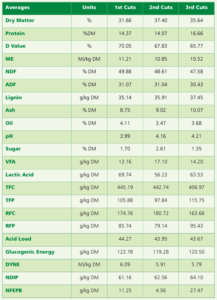Before we reached the end of June many farms already had 2nd cut in the clamp where quantity and quality gave us every reason to be optimistic about winter stocks. In this industry we continue to learn how quickly things can change, the heat waves preceded the droughts and whilst some areas in the North have remained green, others have dried up and grass growth rates plummeted.
Grass growth rates supplied by Trouw Nutrition through AgriNet show a significant drop in growth rates when the heat began, and recovery is yet to happen, leaving many farmers concerned over winter silage stocks. There is however a silver lining as qualities are strong and should give farmers the opportunity to reduce feed costs providing that the quantity is there. As seen in the table overleaf, grass silage averages, analysed by NWF Agriculture’s in house FAA approved laboratory, show some strong positives but also some areas for concern.
Dry matters are very good, a dryer silage (32 – 35%DM) reduces the risk of clostridial fermentation which will help nutrient retention and palatability, and can help with rumen health. The risk with silages over 35% DM is heating in the clamp. 2nd and 3rd cuts both average over 35% DM so keeping a tight clamp face and ensuring oxygen is excluded from the clamp is essential. Typically pH should be 3.8 – 4.1, this can lift a little on dryer silages but if silage is higher than 35% DM and 4.5pH stability could be a concern. If heating and mould does occur, consider using a mycotoxin binder and Selko TMR to help prevent the mix from warming throughout the day.
Whilst last year’s levels were very low, crude protein is typically 1 – 2% higher this year, with all cuts averaging over 14%. This is a welcome relief and can help reduce the purchase of rumen degradable protein and focus more on supplementation on the use of by-pass protein i.e. use homegrown forage for rumen protein and purchased feeds for by-pass protein.
Energy levels are typically 0.1ME higher than last year, which should deliver a 0.23 litre/head/day lift in milk yield. Since silage is dryer and has a lower acid load (likely due to a lower lactic acid), rumen health characteristics are good which should help cows utilise the higher digestibility. Watch out for high ME silages that have high lactic acid, it looks good on paper but when lactic acid gets over 90 g/kg this can drop rumen pH. To support rumen health, make sure a suitable buffer is on offer, such as NWF’s Stable Rumen Pak.
Overall forage qualities are looking good, although there is still a big range between cuts and regions across the country. One of the biggest challenges this winter will be the movement from one cut to another, due to the level of variation. This highlights the importance of regular sampling and testing of silage to ensure dietary changes are made accurately and timely to support animal health and performance.
If you require help in interpreting and balancing a silage analysis, please speak to your local NWF Sales Specialist.

